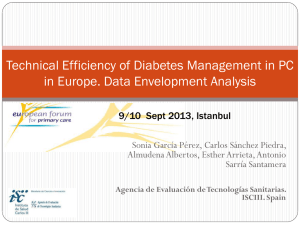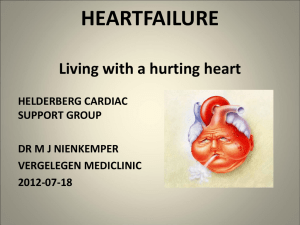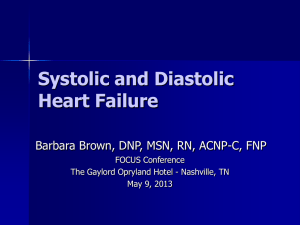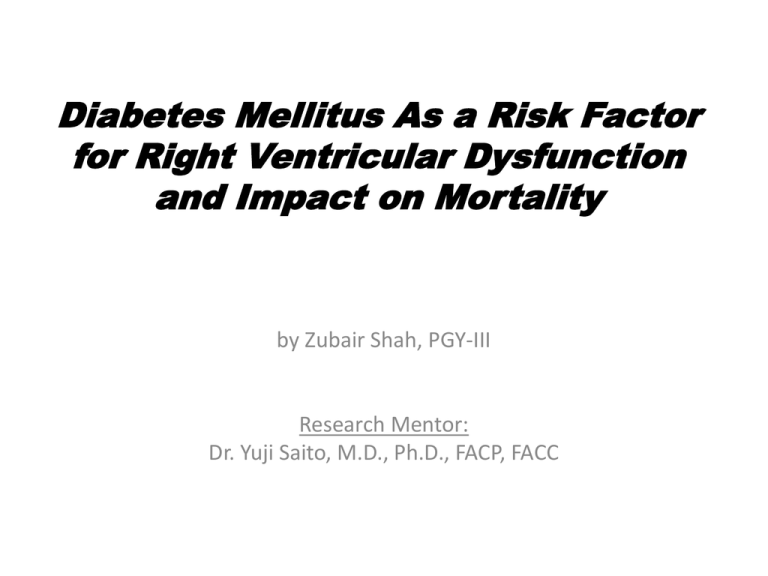
Diabetes Mellitus As a Risk Factor
for Right Ventricular Dysfunction
and Impact on Mortality
by Zubair Shah, PGY-III
Research Mentor:
Dr. Yuji Saito, M.D., Ph.D., FACP, FACC
INTRODUCTION
• Diabetes mellitus is known to increase the risk of heart failure even
in the absence of frequently coexisting predisposing/risk factors
including coronary artery disease and hypertension.
• Epidemiological data indicate a greater risk of cardiovascular
morbidity and mortality in diabetic subjects
• Left ventricular (both systolic and diastolic) impairment in diabetic
patients has been well studied.
• The right ventricular (RV) function plays a significant role in the
overall myocardial contractility. Nevertheless, most of the previous
studies regarding diabetes-induced changes in myocardial
dysfunction were dedicated to the left ventricle (LV) at the cost of
ignoring the role of the right heart chambers
INTRODUCTION CONT’D
• In the clinical practice, right ventricular dysfunction is relevant in a
variety of diseases affecting both the course and prognosis.
Therefore right ventricular performance is also an important issue
in diabetic patients.
• The objective of this study is to determine the potential effect of
diabetes on right ventricular systolic and diastolic function.
• Right ventricular dysfunction (RVD) is defined as an decreased
ejection fraction and/or functional abnormality of diastolic
relaxation and filling.
• RVD is known to be an early complication of hypertension and an
important predictor of prognosis and mortality in various morbid
conditions.
OBJECTIVES
• Determine the potential effect of diabetes on right
ventricular systolic and diastolic function.
• Establish the prevalence of right ventricular dysfunction in
diabetic subjects.
• Reveal other predisposing risks to right ventricular
dysfunction in conjunction with diabetes.
• Determine whether right ventricular dysfunction in
diabetes is a benign condition or associated with increased
mortality.
METHODS: Study Design
• The objectives of the present study were to evaluate the
RV systolic and diastolic functions using conventional
echocardiography in patients with DM LV dysfunction.
• This study is a retrospective data analysis of randomly
selected patients with and without diabetes mellitus, who
had a 2D echocardiogram performed at any Catholic
Health System site between 1/2008 and 1/2012.
• We divided our population mainly into diabetic and
controls (non-diabetics).
METHODS: Inclusion
• Inclusion Criteria for Diabetic Subjects:
– Establish diagnosis of diabetes mellitus as put forth by the American
Diabetic Association.
– A 2D-Echocardiogram performed between 1/2008 to 1/2012.
– No clinical and Echocardiographic of LV dysfunction.
• Inclusion Criteria for Control Subjects:
No clinical and laboratory evidence of diabetes mellitus.
A 2D-Echocardiogram performed between 1/2008 to 1/2012.
No clinical and Echocardiographic of LV dysfunction
METHODS: Exclusion
• Exclusion Criteria for All Subjects:
Any patient who has been diagnosed with LV systolic or diastolic
dysfunction
Any patient with Echocardiographic evidence of low LV EF (50%) or
HFPEF
Any patient with diagnosis of OSA
Any patient with diagnosis of afib/Valvular disease of heart.
Any patient with diagnosis of COPD.
– Randomization and Blinding:
– Both groups will be randomly chosen from Soarian Database
and their demographics will be collected as well.
METHODS: Echocardiography
Using the guidelines put forth by the American Society of Echocardiography 13
the following cardiac parameters are assessed:
METHODS: Echocardiography
• RV Systolic Function
– RV systolic function has been evaluated using several
parameters, namely, RIMP, TAPSE, 2D RV FAC, 2D RV
ejection fraction (EF), three-dimensional (3D) RV EF,
tissue Doppler–derived tricuspid lateral annular
systolic velocity (S0), and longitudinal strain and strain
rate.
– We calculated right ventricular ejection fraction by
using Tricuspid Annular Plane Systolic Excursion
(TAPSE) measured from the apical four-chamber view
at the tricuspid lateral annulus.
– TAPSE < 16 mm indicates RV systolic dysfunction.
METHODS: Echocardiography
• RV Diastolic Dysfunction
– Assessment of RV diastolic function is carried out
by pulsed Doppler of the tricuspid inflow and
tissue Doppler of the lateral tricuspid annulus.
– Right ventricular parameters of diastolic function
that include peak early (E) and peak late (A)
diastolic flow velocity.
– A tricuspid E/A ratio < 0.8 suggests impaired
relaxation and hence diastolic impairment.
Statistical Analysis
• The data are expressed as Mean ± SD and percentages.
• Student unpaired t-test: Evaluate the differences between the groups
• Chi-square test: Compare categorical variables
• Pearson correlation coefficients: Pair the continuous variables. A two-tailed p
value < 0.05 was considered significant.
• Several factors differentiated the patients in the 4 groups.
• Propensity Matching: To evaluate survival with more comparable patients
among the diastolic stages. The variables and the propensity models
incorporated each of the variables regardless of their significance.
• Overall and stratified nonparametric survival estimates were obtained via the
method created by Kaplan and Meier.
• A parametric method was used to resolve the number of phases of
instantaneous risk for death (ie, hazard function) and to estimate the shaping
variables.
• For the statistical analyses, the statistical software Graph pad Prism version 6 was
used.
2860 Initially Screened
• Patients with 2D Echo performed between 1/2008 to
1/2012 and do not meet any exclusion criteria
• 1543 diabetics and 1317 controls
2070 Patients Excluded
• 432 patients with LV systolic or diastolic
dysfunction on 2D Echo
• 87 Afib/Valvuar Dysfunction on 2D echo
• 304 had one or more of exclusion criteria found
on chart review
290 Patients Included
136 Diabetics
• 1337 unsatisfactory 2D echo of the right ventricle
to fulfill our study criteria
154 Controls
STUDY DESIGN
•
2860 Patients (1543 diabetics and 1317 controls) who had 2D Echo performed between
1/2008 and 1/2012 were initially selected from the Sorian Clinical data base for screening.
• This initial selection was done using ICD-9 codes for type 1 and type 2 DM to screen the
diabetic group.
• ICD-9 code used to eliminate patients who had any of the conditions mentioned in the
exclusion criteria: CHF, COPD, Afib, various valvular diseases of the heart and OSA.
•
823 Patients were excluded after screening.
• The screening involved review of the clinical data and 2D echo report from Sorian
Clinical data base.
•
1337 Patients were excluded due to unsatisfactory 2D echo of the right ventricle to fulfill our
study criteria after revision of the 2D Echo study.
•
290 Patients were included for the study (154 controls and 136 diabetic).
•
The clinical data of these patients was obtained using ICD-9 codes from the Sorian clinical
data base.
•
The right ventricular functional status was obtained by studying the 2D Echo from the data
base.
Table 1. Demographic characteristics of the studied groups
Demography/
Co-morbidities
Total
Females
(total/age)
Males
(total/age)
BMI
HBA1C
CAD/MI
CKD
Hypertension
Smoking
Dyslipidemia
Race
African
American
Caucasian
Others
Controls
DM
154
73
65±71.47
136
64
66.11±12.10
81
65±16.43
72
66.51±17.20
24.21±61
5.75±1.55
27.20±50.03
7.06±1.31*
23 (14.95%)
17 (11.37%)
45 (29.32%)
37 (27.22%)*
32 (23.45%)*
24 (14.95%)
27 (17.94%)
84 (63.53%)
20 ( 15.14%)*
49(36.12%)
62 (41%)
75 (56%)*
83 (57%)
54 (40.45%)
9 (6%)
7 (5.14%)
The demographic characteristics and clinical parameters of the participants are depicted in Tables 1. There
were no significant differences between the two groups in terms of sex, age, Race, body mass index,
And smoking. As expected the diabetic group had higher mean HBA1C (7.06±1.31) When compared to
control subjects (5.75±1.55) which was statistically significant. Also diabetic group showed a higher
percentage of CAD/MI, HTN, CKD and dyslipidemia all of which were statistically significant.
Table 2. Echocardiographic and Doppler data of the studied groups
Right ventricular Echocardiographic
parameters
Controls
DM
23.12±2.4
18.15±1.47*
0.46±0.08
0.47±0.01
0.5±0.02
0.4±0.1
1.29±0.31
0.96±0.27*
TAPSE
E
A
E/A
The echocardiographic and Doppler data of the studied groups are illustrated in Table 2. Tricuspid annular
plane systolic excursion (TAPSE), and tricuspid E/A ratio of the diabetic patients (18.15±1.47 vs. 23.12±2.4
and 0.96 ± 0.27 vs. 1.29 ± 0.3, respectively) were significantly lower.
Figure 3. Comparison of number of patients with RVD between two studied groups
Controls
RVD/TOTAL
14/154
%
8.68
DM
29/136
21.32*
Table 3 depicts number of patients with RVD in control subjects 14 (8.68%) Vs Patients with DM 12 (21.32%).
Table 4. Comparison of RVD subtypes between the studied groups
Control/RVD+
DM/RVD+
Low TAPSE
8
5
Low E/A
3
17*
Both
3
7
Table 4 reveals the difference in the types of RVD between the control and diabetic subjects.
While as control subjects with RVD mainly had a low TAPSE. (compare percentages). In
comparison diabetic patients with RVD mainly had a low E/A ratio. (compare percentages)
Figure 2. Comparison of number of patients with low TAPSE AND E/A ratio between two groups
Figure 2 depicts total number of patients with low TAPSE and E/A in control subjects 11 (78.5%), 6(27%) Vs
Patients with DM 12 (41%), 24 (82.75%) respectively.
Table 5. Demographic characteristics of the various subgroups divided on basis of presence or
absence of RVD Demographs/ Control/RVD - Control/RVD+ DM/RVDDM/RVD+
Co-morbidities
Number/Total 140/154
14/154
107/136
29/136
Percentage
91.01%
8.68%
78.67%
22.32%*
Females
(total/age)
68
64±17.47
5
66.51±17.60
53
67.22±16.78
11
63..51±17.60
Males
(total/age)
72
65±16.43
9
66.51±17.20
54
66.22±13.55
18
62.49±17.20
BMI
24.51±18.99
26.20±10.08
27.33.22±10.64
30.18±12.08*
HBA1C
5.15±1.65
5.6±1.81
7.26±1.74
8.36±1.21*
CAD/MI
19 (13.57%)
2 (15.35%)
28(26.43%)
8(27.76%)
CKD
15(10.71%)
2 (15.35%)
27(25.84%)
7 (24.13%)
Hypertension 40 (28.37%)
4 (30.70%)
52 (48.47%)
7 (79.67%)*
Smoking
21 (15.32%)
3 (21.53%)
17 (16.07%)
4 (13.79%)
Dyslipidemia
24(16.95%) *
3 ( 21.53%) *
42(39.23%)
10 (33.53%) *
Race
African
American
Caucasian
Others
55(39.28%)
78 (55.71%)
7 (5%)
7 (50%)
5 (35.71%)
2 (14.28%)
56 (52.33%)
47 (44%)
4 (3.7%)
19 (65.55%)*
7 (24.18%)
3 (10.3%)
The demographic characteristics and clinical parameters of the patients are depicted in
Tables 5. The studied subjects are dived into four subgroups based on presence or
absence of RVD. There is a significant differences between the four groups in terms of
Race, BMI, mean HBA1C and HTN. Patients with DM and RVD+ have higher mean HBA1c
and BMI. Also greater percentage of patients in this group had HTN and belong to AA race.
These differences were statistically significant. These results are depicted in figures 3a, 3b,
3c and 3d respectively.
*
*
*
*
*
*
*
Figure 4 indicates risk factors associated with RVD in diabetic patients. Note 65.51% patients
have 3 or more risk factors which a statistically significant association. 31.03% patients with
DM and RVD have 3 risk factors and 34.48% have 4 risk factors again a statistically significant
association.
CONCLUSION
• Our study indicates that DM is an independent risk factor for development of RVD.
High BMI and HBA1c, African American race and HTN are risk factors in diabetic
patients for development of RVD.
• RVD in diabetic population is an independent risk factor for mortality. Our study
highlights the importance of monitoring right ventricular function in diabetic
population especially with additional risk factors.

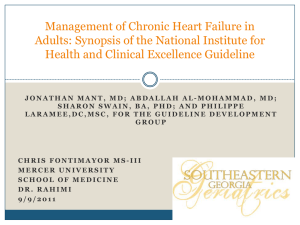

![Cardio Review 4 Quince [CAPT],Joan,Juliet](http://s2.studylib.net/store/data/005719604_1-e21fbd83f7c61c5668353826e4debbb3-300x300.png)
